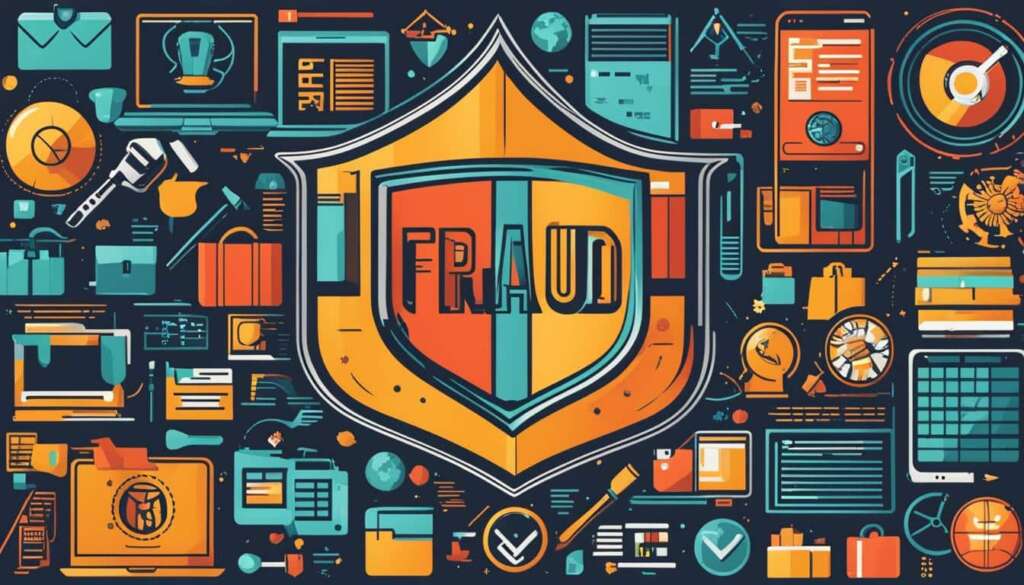Table of Contents
E-commerce fraud, also known as payment fraud, is a serious concern in the digital age. Criminals exploit vulnerabilities in online shopping and transactions to gain unauthorized access to personal and financial information. The repercussions can be significant, leading to financial losses, unauthorized transactions, and reputational damage for businesses.
In this article, we will explore the different types of e-commerce fraud and the steps businesses can take to prevent it. By understanding the risks and implementing robust prevention and detection strategies, businesses can safeguard their online transactions and protect their customers.
Let’s delve into the world of e-commerce fraud and discover how to combat this growing threat.
Types of E-commerce Fraud
E-commerce fraud encompasses various types of fraudulent activities. These include:
- Identity Theft: Occurs when a fraudster uses someone else’s personal information to make unauthorized purchases. This can lead to financial loss and damage to the victim’s reputation.
- Credit Card Fraud: Involves the unauthorized use of a credit or debit card to make fraudulent transactions, resulting in financial losses for both individuals and businesses.
- Chargeback Fraud: Customers falsely claim they didn’t receive a product or service, seeking refunds despite having received the item. This practice can result in financial losses for businesses.
- Account Takeover Fraud: Unauthorized parties gain access to a user’s account, allowing them to make fraudulent transactions or steal personal information.
- Phishing and Social Engineering: Tactics used to deceive users into providing sensitive information, such as passwords or credit card details, through fake emails, websites, or phone calls.
- Refund Fraud: Fraudsters submit fraudulent refund requests, often using fake identities or fabricated reasons, to receive refunds without returning the purchased item.
- Affiliate Fraud: Involves the abuse of an affiliate marketing program, where fraudsters manipulate the system to earn illegitimate commissions or engage in fraudulent activities.
- Counterfeit or Fake Products: Fraudsters sell counterfeit or fake products, misrepresenting them as genuine brands or goods. Consumers unknowingly purchase substandard or dangerous items.
- Drop-shipping Fraud: Fraudulent actors pose as legitimate suppliers, accepting orders but failing to fulfill them or providing low-quality products, resulting in customer dissatisfaction.
E-commerce Fraud Types Comparison Table
| Fraud Type | Description | Impact |
|---|---|---|
| Identity Theft | Unauthorized use of personal information for fraudulent purchases. | Financial loss, damage to reputation. |
| Credit Card Fraud | Unauthorized use of credit or debit cards for fraudulent transactions. | Financial loss for individuals and businesses. |
| Chargeback Fraud | Falsely claiming non-receipt of products to receive refunds. | Financial loss for businesses. |
| Account Takeover Fraud | Unauthorized access to user accounts to make fraudulent transactions or steal information. | Financial loss, compromised data. |
| Phishing and Social Engineering | Tricking users to provide sensitive information through fraudulent emails, websites, or calls. | Financial loss, compromised privacy. |
| Refund Fraud | Fraudulent refund requests without returning purchased items. | Financial loss for businesses. |
| Affiliate Fraud | Abuse of affiliate marketing programs for illegitimate commissions or fraudulent activities. | Financial loss, reputational damage. |
| Counterfeit or Fake Products | Selling counterfeit or fake products misrepresented as genuine. | Financial loss, consumer harm. |
| Drop-shipping Fraud | Deceiving customers by posing as legitimate suppliers and not fulfilling orders. | Financial loss, customer dissatisfaction. |
E-commerce Fraud Trends and Future Predictions
E-commerce fraud is an ever-changing landscape, with fraudsters constantly adapting and deploying more sophisticated tactics. Understanding the latest fraud trends and making future predictions is instrumental in developing effective fraud prevention and detection strategies. Here are the key trends shaping the future of e-commerce fraud:
- The Growing Sophistication of Attacks: Fraudsters are becoming increasingly savvy, utilizing advanced techniques to bypass security measures and exploit vulnerabilities in e-commerce systems.
- The Rise in Mobile Commerce Fraud: As mobile commerce continues to gain popularity, fraudsters are targeting mobile platforms and exploiting weaknesses in mobile payment processes.
- Increased Use of Artificial Intelligence and Machine Learning: Fraudsters are harnessing the power of AI and machine learning algorithms to automate and optimize their fraudulent activities, making detection more challenging.
- Growth in Account Takeover Fraud: Account takeover fraud, where fraudsters gain unauthorized access to user accounts, is on the rise. This type of fraud poses a significant threat to both businesses and their customers.
- Increased Focus on Data Security and Privacy Regulations: With the introduction of stricter data security and privacy regulations, such as the GDPR, businesses are under increasing pressure to protect customer data from unauthorized access and breaches.
- Collaboration and Information Sharing Among Businesses and Law Enforcement Agencies: The fight against e-commerce fraud requires collaboration and information sharing between businesses, financial institutions, and law enforcement agencies to identify and apprehend fraudsters.
- The Growing Role of Biometrics and Behavioral Analytics: Biometric authentication methods, such as fingerprint scans and facial recognition, along with behavioral analytics, are becoming more prevalent in fraud detection and prevention efforts.
These trends illustrate the evolving nature of e-commerce fraud and highlight the importance of staying informed and proactive in implementing robust fraud prevention and detection strategies.

Future Predictions:
As technology advances, so too will the tactics used by fraudsters. It is predicted that the integration of emerging technologies, such as blockchain and advanced biometrics, will play a crucial role in enhancing the security of e-commerce transactions. Additionally, machine learning algorithms will continue to evolve, enabling more accurate fraud detection and prevention mechanisms. It is imperative for businesses to adapt and invest in innovative solutions to stay ahead of fraudsters and protect their customers and assets.
E-commerce Fraud Prevention and Detection
E-commerce fraud prevention and detection are essential for online businesses to safeguard their operations and protect their customers from fraudulent activities. By implementing effective strategies and staying informed about evolving fraud trends, businesses can minimize the risk of e-commerce fraud.
Key Strategies for Fraud Prevention and Detection
Implementing the following key strategies can significantly enhance fraud prevention and detection efforts:
- Utilize Secure Payment Gateways: Ensure that your e-commerce platform integrates secure payment gateways with robust fraud prevention features. These gateways often employ advanced algorithms and machine learning models to analyze transactions for potential fraudulent activity.
- Implement Strong Authentication: Implement a multifactor authentication process to secure customer accounts and prevent unauthorized access. By requiring multiple forms of verification, such as passwords, SMS codes, or biometric data, businesses can significantly reduce the risk of account takeover fraud.
- Monitor Transactions and User Behavior: Regularly monitor transactions and analyze user behavior to identify any anomalies or suspicious patterns. Automated systems can flag transactions with unusual characteristics, such as high-value purchases from new customers or multiple transactions within a short period.
- Analyze Customer Data: Leverage customer data to identify patterns of fraudulent behavior. By analyzing factors like purchase frequency, location, and transaction history, businesses can spot anomalies and take appropriate action to prevent fraudulent activities.
- Monitor IP Addresses: Pay close attention to IP addresses associated with transactions and monitor them for suspicious activity. Unusual IP address changes or connections from known fraud hotspots can indicate fraudulent behavior.
- Stay Informed: Stay updated on fraudulent trends and emerging fraud prevention technologies. Regularly educate yourself and your team about the latest fraud techniques and ways to combat them effectively. Professional communities, industry reports, and security conferences can be valuable sources of information.
Additional Measures for Enhanced Security
To bolster e-commerce fraud prevention and detection efforts, businesses should consider the following measures:
- Partner with Reputable Payment Processors: Collaborate with trusted payment processors that offer robust fraud prevention measures. These processors often leverage sophisticated tools and techniques to detect and prevent fraudulent transactions.
- Maintain a Secure Website: Ensure your website is secure by implementing measures such as firewalls and HTTPS encryption (using SSL/TLS certificates). Regular vulnerability scanning and patching, along with secure server configurations, can further enhance security.
- Comply with PCI-DSS: Adhere to Payment Card Industry Data Security Standards (PCI-DSS) guidelines to protect sensitive customer data. Compliance with these standards ensures that businesses follow best practices for storing, processing, and transmitting cardholder information.
- Update Fraud Prevention Software: Regularly update fraud prevention software to stay ahead of evolving fraud tactics. Software providers often release updates that address new vulnerabilities and enhance fraud detection capabilities. Keeping the software up to date is crucial for maintaining robust protection.
Enhancing e-commerce fraud prevention and detection not only protects businesses from financial losses but also helps maintain customer trust and uphold the integrity of the digital marketplace. By implementing these strategies and measures, businesses can strengthen their defenses against e-commerce fraud and provide a secure shopping experience for their customers.
Industry Best Practices for E-commerce Fraud Detection
To effectively detect and prevent e-commerce fraud, it is important to implement the following best practices:
Analyze Customer Data
Thoroughly analyzing customer data can provide valuable insights into patterns of fraudulent behavior. By monitoring factors such as purchase history, device fingerprinting, and geolocation, businesses can identify suspicious transactions and take appropriate action.
Monitor IP Addresses
Tracking IP addresses associated with online transactions allows businesses to identify potentially fraudulent activity. By monitoring IP addresses and comparing them to known blacklists or suspicious geolocations, businesses can enhance fraud detection capabilities.
Keep Track of Fraudulent Activity in Different Regions
Because e-commerce fraud can occur on a global scale, it is crucial to stay informed about fraudulent activity in different regions. Understanding regional trends and emerging fraud tactics can help businesses proactively anticipate and prevent fraudulent activity.
Use Available Tools and Resources
Utilize tools and resources such as authentication steps, card verification value (CVV), address verification service (AVS), and 3D Secure 2.0. These tools can provide an additional layer of fraud prevention by validating customer information and reducing the risk of fraudulent transactions.
Partner with Reputable Payment Processors
Collaborating with reputable payment processors can significantly enhance fraud detection capabilities. These processors often have advanced fraud management systems in place, offering real-time monitoring, data analysis, and risk assessment to protect businesses and customers.
Maintain a Secure Website
Ensuring a secure website is essential for preventing e-commerce fraud. Implement firewalls, HTTPS encryption, and other security measures to safeguard customer data and protect against unauthorized access. Regularly test and update security protocols to stay ahead of evolving fraud tactics.
Comply with PCI-DSS
Compliance with Payment Card Industry Data Security Standards (PCI-DSS) is crucial. This set of security standards ensures that businesses maintain robust security measures to protect customer payment card data. Adhering to PCI-DSS guidelines can minimize the risk of e-commerce fraud.
Keep Software Up to Date
Regularly update fraud prevention software and technologies to stay current with evolving fraud tactics. Ongoing updates and patches help businesses stay one step ahead of fraudsters, ensuring effective fraud detection and prevention.
By implementing these industry best practices, businesses can strengthen their fraud detection capabilities, mitigate the risk of e-commerce fraud, and protect both their own interests and the trust of their customers.
Conclusion
E-commerce fraud poses significant risks to online businesses, their customers, and the overall integrity of digital commerce systems. With the increasing sophistication of fraudsters and evolving fraud trends, it is crucial for businesses to stay informed and proactive in preventing and detecting fraudulent activities. By understanding the types of fraud and implementing effective prevention and detection strategies, businesses can safeguard their online transactions and maintain customer trust.
Industry best practices such as using secure payment gateways, implementing strong authentication, and monitoring transactions for anomalies can help mitigate the risk of e-commerce fraud. It is also important to leverage available tools and technologies such as authentication steps, card verification value (CVV), and address verification service (AVS). Partnering with reputable payment processors and maintaining a secure website with proper security measures are essential in protecting businesses and customers.
By following these best practices and staying up to date with the latest fraud prevention technologies, businesses can ensure a secure shopping experience for their customers. Mitigating the risk of e-commerce fraud not only protects businesses from financial losses and reputational damage but also contributes to the overall integrity and trustworthiness of the digital commerce ecosystem.
FAQ
What is e-commerce fraud?
E-commerce fraud, also known as payment fraud, refers to criminal activities that target online shopping and transactions. It involves malicious actors exploiting vulnerabilities in digital commerce systems or manipulating businesses and customers to gain unauthorized access to sensitive personal or financial information.
What types of fraudulent activities are considered e-commerce fraud?
E-commerce fraud encompasses various types of fraudulent activities such as identity theft, credit card fraud, chargeback fraud, account takeover fraud, phishing and social engineering, refund fraud, affiliate fraud, counterfeit or fake products, and drop-shipping fraud.
What are the current trends in e-commerce fraud?
Current trends in e-commerce fraud include the growing sophistication of attacks, the rise in mobile commerce fraud, increased use of artificial intelligence and machine learning, growth in account takeover fraud, increased focus on data security and privacy regulations, collaboration and information sharing among businesses and law enforcement agencies, and the growing role of biometrics and behavioral analytics in fraud detection and prevention efforts.
How can businesses prevent and detect e-commerce fraud?
To prevent and detect e-commerce fraud, businesses can implement strategies such as using secure payment gateways, implementing strong authentication, monitoring transactions and user behavior for anomalies, analyzing customer data, monitoring IP addresses for suspicious activity, staying informed about fraudulent trends, and partnering with reputable payment processors.
What are some industry best practices for e-commerce fraud detection?
Industry best practices for e-commerce fraud detection include analyzing customer data, monitoring IP addresses, keeping track of fraudulent activity in different regions, using authentication steps, card verification value (CVV), address verification service (AVS), and 3D Secure 2.0, partnering with reputable payment processors, maintaining a secure website with firewalls and HTTPS encryption, complying with payment card industry data security standards (PCI-DSS), and keeping fraud prevention software up to date.













